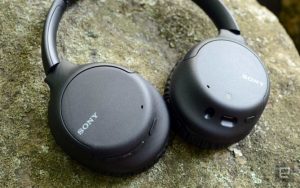Some YouTube channels always have buttery smooth video, even when the person is walking around. Other YouTubers struggle to keep the camera steady when they’re sitting still. The difference between the two lies in a device called a gimbal, a tri-axis device that tilts, pans, and pitches to compensate for shaky hands and body movement. It helps keep footage stable and relatively free of jitters.
DJI’s revamped Osmo Mobile 3 brings that buttery smooth video to your phone. (DJI also released an Osmo Action cam and wheeled drone earlier this year.) Slide your phone into the tension tray and activate DJI’s Mimo app. Depending on the video quality of your phone, you may have a better setup than Alfred Hitchcock used to film his masterpieces.
Phone Vlogging Nirvana
As the name suggests, the Osmo Mobile 3 is DJI’s third take on this gimbal and it’s very much an iteration on the previous model, fixing most of the pain points while adding some nice new features to the software.
Photograph: DJI
While DJI is not the first phone gimbal with a folding design, it’s the simplest I’ve used. Unlike some gimbals with lots of twists and latches, this is one piece. Extend it and you’re ready to go. Fold it up—even with your device still attached—and it’s ready to pack away.
The foldable design also makes the Osmo Mobile incredibly easy to carry around. If you opt for the slightly more expensive bundle ($139), the handy carrying case fits easily in a bag. The gimbal itself weighs just over 14 ounces and fits any phone between 2.5 and 3.5 inches wide (62–88 millimeters). I tested it with a Motorola Moto X4, Sony Xperia 1, and an iPhone 8, which all fit, though I had to remove the X4’s case.
Mounting your phone is also simple. There are no screws—just a spring-loaded tension grip. It feels plenty secure and can fit larger phones than the previous model, meaning those giant Galaxy S10 phones should do just fine (again, thick cases may not fit). DJI says the new mount design decreases the chances of the mount pressing your phone’s hardware buttons since it has a lighter grip and holds onto a smaller area of your phone’s edge.
The design gives you easy access to your phone’s charging port and headphone jack (if it has one, that is). You could add an external microphone to your setup for improved sound quality, something vloggers will be happy to hear.
The front handle trigger mechanism is also back on the Osmo Mobile 3—a feature that the first-generation Osmo Mobile had and the Mobile 2 dropped. The trigger now lets you lock the gimbal, re-center, track, activate “sport” mode (more on that in a minute), and switch between front and back cameras.
There are two other buttons and a joystick under your thumb—enough controls that you can operate the Osmo Mobile almost entirely with one hand. There’s plenty about DJI’s Mimo mobile app that requires two hands, but I almost never needed to use a second hand when I was actually filming.
DJI claims 15-hours of battery life and that’s what I’ve seen while testing. Along with that battery life comes a new full-size USB port that can charge devices from the Osmo. I was happy to sacrifice a few hours of gimbal time to keep my phone going since nothing drains your phone quite like shooting 4K video. It’s also worth noting that the Osmo Mobile 3 support USB-C for fast-charging on devices that support it.
Easy isn’t always better. My least favorite new feature is the quick swapping between vertical and horizontal orientations. All you need to do is tap the lower button twice and your phone will rotate into vertical mode. But seriously, don’t do that. The world does not need more portrait-mode video.
Smart Software
While the gimbal hardware is impressive, most of what I like about the Osmo Mobile comes down to software in the DJI Mimo app. The intelligent filming features like ActiveTrack, Hyperlapse, and Motionlapse all make it easier to get great video results, even from a phone.
ActiveTrack in particular works incredibly well. All you have to do is tap and drag a box over the object you want to track and the app will do the rest. In my testing, it easily handled situations where you lock onto a fixed object and move around it, and when you lock on a moving object and the gimbal tracks it.
I was able to track most things with ActiveTrack—the exception being my kids running and cartwheeling across the room. They were just too fast to ActiveTrack. To capture that I switched to Sport Mode by pressing the trigger twice and then long-pressing it for a few seconds. That speeds up the gimbal, so you can manually pan much faster, but you do lose the ActiveTrack auto-follow feature. After you’ve developed some skill with the gimbal, Sport Mode is a huge asset. Hyperlapse mode is also fun. It creates time-lapse videos while you’re in motion.
The app has a couple of other new features, including Story Mode, which helps you create videos quickly using pre-set shooting templates with matching music, and a panoramic photo mode which takes multiple images and stitches them together to create either a 180-degree or 330-degree image.
The app also lets you use gesture control, which is especially useful when recording yourself. The Osmo Mobile bundle package includes a small tripod, which means you can step out from behind the camera and use a hand gesture to take a photo or start recording video. The gimbal will then track your movement.
The Osmo Mobile 3 is more compact, easier to use, and has more hardware and software features than its competitors. My only real gripe is that currently shooting at 60 fps is limited to iPhones, but I’ve learned that is more of a problem with Android phones.
DJI has its gimbal game on lock; just where a gimbal should be.
You can buy the Osmo Mobile 3 for $119 at DJI’s store , Amazon, Best Buy, or B&H Photo. If you can afford it, I suggest upgrading to the Combo bundle for $139, which adds a nice case and small tripod. You can also get the Combo bundle at Best Buy, or B&H.



